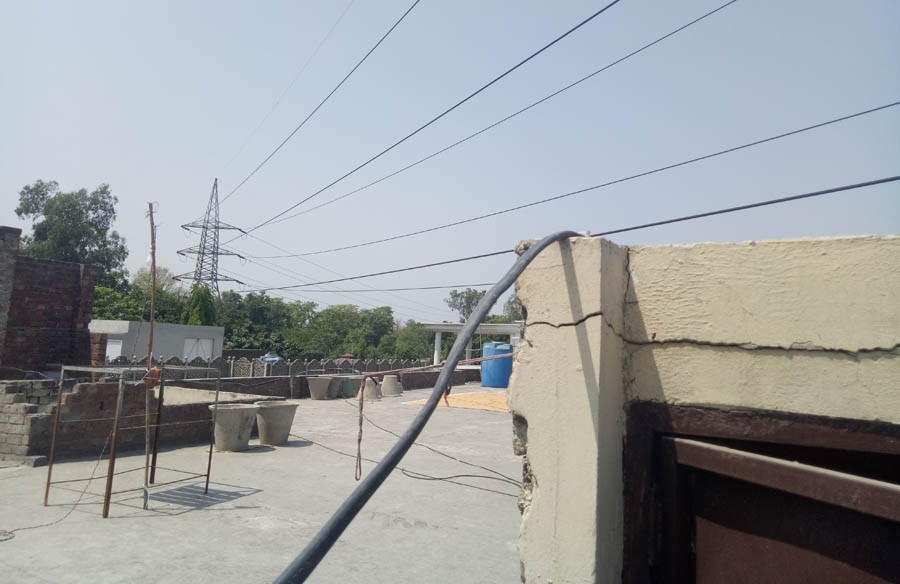
Living under high-tension electricity wires is a life hazard, and can cause serious medical conditions such as infertility and even cancer

In a newly built housing society along the Upper Canal Bank, stand huge pylons carrying high-tension electricity wires with high-voltage current flowing through.
At points, these wires pass over the houses and streets as well as open areas such as the green spaces. There are locations where these wires have loosened and hang close to the rooftops, making contact possible with the residents or the structures. The situation is even worse where there are metallic objects like antennas, steel doors, railings fixed there.
There are many areas in the city and beyond where the situation is the same but there is no plan in place on how to tackle the issue. The LESCO authorities have received countless applications but remain helpless because huge funds are required to re-route these lines or lay them underground.
Babar Bin Dilawar, a resident of Upper Canal Bank, says that the people of Harbanspura, Journalist Housing Colony, Lahore Medical Society, Baghbanpura and Sajid Garden have been suffering for long because of High Transmission Lines (HTLs) (132KVA) passing over their houses.
According to him, a 28-year-old man, named Majid Ali, died of electric shock when he went to the rooftop of his house just to check the water tank and accidentally got in contact with a live wire.
Dilawar quotes another incident where a six-year-old boy who was playing on the roof of his house in Harbanspura died after receiving electric shock.
The Lesco authorities hold people responsible for the dangerous environment. The lines were installed when these houses were not there. They came up later. Those who sold this land and those who built double-storey houses underneath the high-tension wires are termed responsible for the mess.
Dilawar says this debate is irrelevant: "What we need to focus on is how to resolve the issue. Children in these areas are not allowed to climb their rooftops. Moreover, because of HTLs mobile services are almost non-functional. Internet is also not functioning here, and screens of television and laptops are affected because of the Electro Magnetic Field (EMF) high-tension wires generate here."
Mobeen Ahmed, a resident of Harbanspura, says they have collectively submitted applications to Chairman WAPDA, LESCO head and Chief Minister of Punjab to remove HTLs from their rooftops but they only got promises from them to look into the matter.
The hazards associated with HTLs are immense. Some examples of what these can do, follow: In August, 2016, Muhammad Muddasar, a rescue 1122 driver was electrocuted when steel ladder of the rescue vehicle came in contact with a high-tension wire. It carried such high voltage that the vehicle caught fire.
In November 2011, six labourers died of electric shock in Shadab Colony area when the crane they were working on came in contact with the live high voltage power wires.
Farooq Butt, central member of Pakistan WAPDA Hydro Electric Union (CBA) endorses the argument raised by Dilwar. He says government can release funds for laying cable system underground in the city. This, he says, will solve this issue as well as save 17 per cent line losses of electricity. Additionally, no pole would fall during rain and storm. Precious lives can be saved by adopting underground cable system. "This model has been adopted by Bahria Town, Paragon City and other modern housing societies. Why is the government reluctant to adopt this system?"
Imran Afzal, spokesman, Lesco, says that people have built their houses under the poles where the HTLs were passing. "They should have avoided this."
He also says that Lesco does not have enough resources to lay wires underground, though it plans to do so in the future. "Special cable called gola can be wrapped around these lines to make them safe, but this solution is also costly. Lesco can go for this solution if it has funds."
"Nothing is more important than human life," says Farooq Butt. "Once the HTLs are moved underground, the plan will work forever. Therefore, the investment is highly cost-effective.
"The government has resources to solve the problem but it lacks the political will to do so," he adds.
In addition to the risks of electrocution, the HTLs may cause different diseases among people living in close proximity. The reason is that strong electronic magnetic fields generated by them are very harmful. According to the World Health Organization (WHO), these magnetic fields affect the people’s digestive system, nervous system, and heart and brain functions by virtue of our own biochemical and electrical responses. When these systems are exposed to electro magnetic fields caused by the flow of high-voltage electric current, they interfere with human body’s communication processes and can affect its function in various adverse ways.
Scientific studies have found evidence that brain tumours, cancers, autism in children, low sperm count among men, and reduced fertility in women are all linked to excessive exposure to electro magnetic fields.